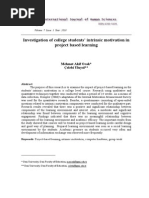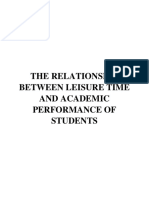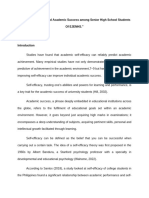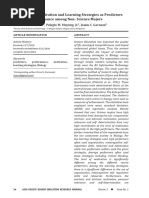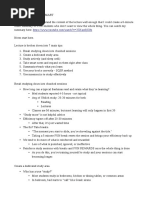Motivasi Fisika
Motivasi Fisika
Uploaded by
Muhammad Bahar SofiuddinCopyright:
Available Formats
Motivasi Fisika
Motivasi Fisika
Uploaded by
Muhammad Bahar SofiuddinOriginal Title
Copyright
Available Formats
Share this document
Did you find this document useful?
Is this content inappropriate?
Copyright:
Available Formats
Motivasi Fisika
Motivasi Fisika
Uploaded by
Muhammad Bahar SofiuddinCopyright:
Available Formats
International Journal of Education and Research
Vol. 3 No. 2 February 2015
Physics Motivation and Research: Understanding the 21st Century Learners of
Today
Von Anthony Gayas Torio
Faculty member, Institute of Teaching and Learning
Philippine Normal University
Taft Avenue, Manila
torio.vag@pnu.edu.ph
+639286232806
Abstract
Motivation and Research are significant determinants in a students success in the future.
This study aimed to give a picture of the physics motivation of students in a tertiary level institution
as well as gender differences in its components. Research and working preference of the learners
were also provided.
Results revealed that male students (M=4.27; SD=0.74) have significantly higher
motivation as compared to female students (M=3.77; SD=0.89) with a computed t(64) value of 2.41
with p<0.05 and Cohens d of 0.61. It was further found that male students have higher motivation
than female students in all other components of motivation.
These results gave a picture of 21st century learners of today in terms of motivation and
conduct of research. The students preference to work in groups of three rather than working
individually suggests that students of the batch have small working groups that they depend on
rather than self-belief.
Keywords: Motivation, Physics, Research, Physics Motivation, Physics Education, Philippines
1. Introduction
The recognition of the diversity of 21st century learners is crucial in pushing for educational
reforms. Understanding the students of today will help educators better guide them in the career that
will define the quality of citizens that the students will become in the coming future. Their
motivation to study science and to pursue research are critical in nation building. Educators play a
significant role in defining students of today and identifying their motivational needs in the fields of
science. Their needs and interest towards the conduct of research to generate new knowledge and to
find solutions to current difficulties are also essential needs for national reforms.
The Basic Education Curriculum (BEC) of the Philippines is on its way to complete
reformation. This year is the last year of the BEC 2002 in our country. The Enhanced Basic
125
ISSN: 2201-6333 (Print) ISSN: 2201-6740 (Online)
www.ijern.com
Education Curriculum of the Philippines dubbed as K12 curriculum is already on its third year of
implementation in the public schools. Both curricula aims to lead students towards productive
citizens of the nation. One leading conception towards productivity in the work field and even early
in school is motivation.
The gender differences in science led researchers to look into motivation as plausible reason.
In other countries, gender differences led to the under representation of women in the field of
science as cited in the paper of Taasoobshirazi (2007). Mattern and Schau (2002) found that women
showed substantially low motivation to participate in science classes and in pursuing science
careers. Klein and Hodges (2001) conducted two studies about college students that together
resulted to suggest that there are motivational differences between men and women which are not
due to simple differences of abilities.
In the study of Glynn and Koballa (2006), they identified six components of motivation.
These components include the following: intrinsic motivation, extrinsic motivation, relevance of the
task to personal goals, self-determination, self-efficacy, and assessment anxiety. A wide range of
literature discusses these different motivational components.
Oudeyer and Kaplan (2008) described intrinsic motivation as the drive/r of spontaneous
exploration and curiosity. They even proposed a way of defining intrinsic motivation in a manner
that will help spark research in more systematic studies about it. According to Ryan and Deci
(2000),Intrinsic motivation is defined as the doing of an activity for its inherent satisfaction rather
than for some separable consequence. When intrinsically motivated, a person is moved to act for
the fun or challenge entailed rather than because of external products, pressures or rewards.
Froiland, et. al. (2012) in their study about intrinsic motivation noted that, Intrinsic
motivation to learn, if cultivated, can lead to many academic and social/emotional improvements
among K-12 students. The study of Froiland (2012) also stressed the requirement of autonomy
supportive home and school environment. Benefits of intrinsic motivated students include the
following: more learning, better behaviour, happier, greater sense of well-being, more engaged in
the classroom, treat others well, and are truly contributing to the betterment of the society.
Extrinsic motivation on the other hand, was defined by Ryan and Deci (2000) as, a
construct that pertains whenever an activity is done in order to attain some separable outcome.
Extrinsic motivation thus contrasts with intrinsic motivation, which refers to doing an activity
simply for the enjoyment of the activity itself, rather than its instrumental value.
Deci, Koestner and Ryan (2001) conducted a meta-analysis that provides a strong support to
the idea that tangible rewards have substantial undermining effect on intrinsic motivation. The
belief that extrinsic and intrinsic motivation are antagonistic in nature, meaning, that the will to
learn associated with intrinsic motivation is inhibited by the presence of extrinsic motivation, was
countered by the study of Covington and Mueller (2001). They claimed that the antagonistic nature
is dependent upon the theoretical perspective adopted. The use of the need achievement theory leads
to a different conclusion. With this new perspective, intrinsic motives may coexist with extrinsic
motives and that learning can be stimulated in their own right in the school settings.
126
International Journal of Education and Research
Vol. 3 No. 2 February 2015
Self-determination and relevance to personal goals are part of the self-determination
continuum (Deci & Ryan, 2002). Ryan and Deci (2000) referred to self-determination as a students
freedom to have some choice and control of their learning. The goal setting theory is believed to be
consistent with the cognitive revolution (Locke, 1996). It emphasizes the significant relationship
between goals and performance (Lunenberg, 2011). Locke proposed 14 categories to present the
basic contents of goal setting theory. Some of the striking categories include the following: (1) The
more difficult the goal, the greater the achievement; (2) The more specific or explicit the goal, the
more precisely performance is regulated; (3) Goals that are both specific and difficult lead to the
highest performance; (5) High commitment to goals is attained when (a) the individual is convinced
that the goal is important; and (b) the individual is convinced that the goal is attainable (or that, at
least, progress can be made toward it); and (9) Goals affect performance by affecting the direction
of action, the degree of effort exerted, and the persistence of action over time.
Self-efficacy has several other names including social cognitive theory and social learning
theory (Lunenburg, 2011). Bandura (1997) defined self-efficacy as a persons belief that he/she is
capable of performing a particular task successfully. Bandura (1982) enumerated three ways in
which self-efficacy affects learning and performance:
1) Self-efficacy influences the goals that employees choose for themselves;
2) Self-efficacy influences learning as well as the effort that people exert on the job; and
3) Self-efficacy influences the persistence with which people attempt new and difficult
tasks.
In the paper of Lunenburg (2011) about Self-efficacy, he noted that self-efficacy influences
the tasks chosen by an individual to learn and the goals that they set for themselves. In addition,
four sources of self-efficacy were also cited which includes past performance, vicarious experience,
verbal persuasion, and emotional cues.
The final component is assessment anxiety. Huberty (2009) defined anxiety as, a normal
human emotion that can be detrimental in a school setting, but good communication and support
can help minimize its negative impact. He further classified anxiety into two, trait anxiety and
state anxiety. While taking examinations, a student may experience both types, high trait anxiety
may be a sign of significant emotional problems and may be a precursor to depression. Cassady and
Johnson (2002) cited that a moderate level of anxiety is necessary for students to perform best.
In this study, physics motivation is examined in order to define the learners of an institution
who are on their last year of their secondary level. Gender differences in motivation were also
examined to give a better picture of the nature of the students. Research interest and working
preference (individual, pair or group of 3) were also examined.
2. Methods
Participants
Two sections of secondary Physics and Research classes were included as samples of this
study. Section A has thirty-five students and section B has thirty four students. All the subjects are
on their last year in the secondary school. There are 26 males (37.68%) and 43 females (62.32%).
This makes a total of 69 subjects in all.
127
ISSN: 2201-6333 (Print) ISSN: 2201-6740 (Online)
www.ijern.com
All of the subjects have taken three quarters of Secondary level Physics classes before they
were asked to respond in the Physics Motivation Questionnaire. They have also completed a year of
research and are all on their final quarter of completing their second year of research. They are also
part of the batch of students who are the last to belong in the 2002 Basic Education curriculum of
the Philippines.
Currently, the Enhanced Basic Education Curriculum of the Philippines is on the third year
of implementation. The first batch of students are already on their Grade 9.
Methods
All the students were introduced to the subject research as an additional course in their Basic
Education Curriculum. The course was introduced on their third year level and was given two hours
of meeting time per week for the entire year. The students were introduced to topics that will help
them be equipped with knowledge about research.
They are also given specific tasks that will help them hone their research skills. Specifically,
the students were tasked to come up with a research proposal which they have defended as a
terminal course requirement on their third year.
On their fourth year in the secondary level, the students took their physics class as the
terminal science course and their second year of research. The same time allotment of two hours per
week was given to the two sections.
The terminal course requirement is to be able to implement a research study. In order to
measure students motivation in physics, an instrument called Physics Motivation Questionnaire
(PMQ) at the end of three quarters of Physics classes. The students were taught Physics using varied
strategies. A physics class has six hours of contact time per week.
Instrument
In determining the level of motivation of the students, an instrument was adopted. This
instrument is called Physics Motivation Questionnaire (PMQ) (Glynn & Koballa, 2006). This PMQ
includes 30 items that assesses six key components of motivation.
The following table shows the six components of motivation considered in the PMQ:
Table 1
Physics Motivation Components
Component
Intrinsically Motivated Physics Learning
Extrinsically Motivated Physics Learning
Relevance of Learning Physics to Personal Goals
Self-determination for Learning Physics
Self-efficacy for Learning Physics
Anxiety about Physics Assessment
Items
1, 16, 22, 27, and 30
3, 7, 10, 15, and 17
2, 11, 19, 23 and 25
5, 8, 9, 20 and 26
12, 21, 24, 28, and 29
4, 6, 13, 14, and 18
128
International Journal of Education and Research
Vol. 3 No. 2 February 2015
Students were tasked to respond to the 30-item adopted PMQ which is in the form of a 5point Likert scale checklist. The scale ranges from 1 (never) to 5 (always). The perspective used in
the questionnaire is on the context of, when learning Physics. The last component among the six,
the Anxiety about Physics Assessment, corresponds to reverse-scored items since the higher score on
this component means less anxiety.
In the study of Glynn and Koballa (2006), they reported that the instrument is reliable with
an alpha coefficient alpha of 0.93. The instrument was also reported to be valid in terms of its
correlation with college students decision to major in science, their science grade, interest in
science careers and the number of science courses they have taken. The study of Taasoobshirazi
(2007) also found a high internal consistency of the instrument when she used it in her study about
Gender differences in Physics.
3. Results
There are 69 students considered in the study. Out of the 69 students, five students did not
respond to the PMQ given to them. This choice of not responding to the questionnaire was
interpreted to mean that the students are not interested to participate in the study. This means that
only 64(92.75%) students were considered in determining their motivation towards learning
Physics.
Table 2 shows the overall result of the different components of motivation of the students.
From the table, it was found that intrinsic motivation followed closely by extrinsic motivation to
learn physics were the top motivational components why students learn physics. Students have the
least motivation in terms of anxiety about Physics assessment.
Table 2
Physics Motivation Average for all students
Component
Intrinsically Motivated Physics Learning
Extrinsically Motivated Physics Learning
Relevance of Learning Physics to Personal Goals
Self-determination for Learning Physics
Self-efficacy for Learning Physics
Anxiety about Physics Assessment
Ratings
3.95
3.87
3.53
3.80
3.38
2.74
In determining the gender differences in motivation, independent sample t-tests were
calculated. Table 3 shows the different means of the components of Physics motivation. Overall, it
was found that there was significant difference in the motivation of men (M = 3.76; SD: 0.99) and
women (M = 3.42; SD = 1.02) with a computed t(64) = 1.296, p<0.05. Cohens d = 0.33 which is
interpreted to have an effect size that is medium.
Table 3
Physics Motivation Average for male and female
Component
Intrinsically Motivated Physics Learning
Extrinsically Motivated Physics Learning
Relevance of Learning Physics to Personal Goals
Self-determination for Learning Physics
Self-efficacy for Learning Physics
Anxiety about Physics Assessment
Overall Motivation
Male
4.27
4.04
3.79
3.92
3.73
2.79
3.76
Female
3.77
3.77
3.38
3.73
3.18
2.71
3.42
129
ISSN: 2201-6333 (Print) ISSN: 2201-6740 (Online)
www.ijern.com
In examining the individual components, table 3 shows the top two components common for
both genders which are intrinsic and extrinsic motivation to learn physics. There was a significant
difference between the intrinsic motivation to learn physics of male (M=4.27; SD=0.74) and
women (M=3.77; SD=0.89) with a computed t(64) value of 2.41, p<0.05 and Cohens d of 0.61.
The intrinsic motivation of men was found to be higher than women. There was also a significant
difference in the extrinsic motivation of men (M=4.04; SD=0.82) and women (M=3.77; SD=0.96)
with t(64) value of 1.19 and Cohens d = 0.30. The extrinsic motivation of male students is also
higher than that of female students.
Gender differences in Physics motivation
5
4
3
2
1
0
Male
Female
Figure 1
Figure 1 shows that the lowest motivation component for both male and female is
assessment anxiety. Male students have higher assessment anxiety in Physics (M=3.79; SD=1.20)
as compared to female (M=2.71; SD=1.22). There was a significant difference in their assessment
anxiety with a computed t(64) value of 3.43, with p<0.05 and Cohens d = 0.89.
In the remaining three components, male students showed a significantly higher motivation
as compared to female. In the component relevance of learning physics to personal goals, male
students (M= 3.79; SD=0.79) have significantly higher motivation than female (M=3.38; SD=
0.79). The computed t(64) being 2.00, with p<0.05 with a Cohens d of 0.52.
In terms of self-determination for learning physics, male students have significantly higher
motivation (M=3.92; SD=0.82) than female students (M=3.73; SD=0.91). The computed t(64) was
0.85, with p<0.05 and Cohens d = 0.22. Finally, in terms of self-efficacy in learning physics, male
students still have higher motivation (M=3.73; SD = 0.76) than female students (M=3.18; SD =
0.74). The computed t(64) value is 2.80, with p<0.05 and Cohens d = 0.73.
Research Themes
The subjects of the study were also introduced to two research subjects as additional courses
in their basic education curriculum. The first research subject was introduced on their third year.
The main objective of the third year research subject is for the students to be acquainted with basic
research skills and concepts in order to arrive at a research proposal. The second research course
aims to implement the research proposal and to present the completed research project.
130
International Journal of Education and Research
Vol. 3 No. 2 February 2015
The students were allowed to choose among multidisciplinary research themes of their
choice. There are five disciplines that a student can choose on. The five disciplines are Applied
Science, Environmental Science, Social Science, ICT, and Health Science. The distribution of the
69 students are given in the table below.
Table 4
Research Interest of the Subjects of the Study
Research Themes
Male
Female
Total
11
Environmental Science
14
23
Social Science
10
16
26
Information and Communication Technology
Health Science
Total
28
41
69
Applied Science
Majority of the students, as shown in Table 4, chose the Social Science field. Both male with
10 students (35.71%) and female with 16 students (39.02%) conducted studies about social science
with greatest numbers. The least number of students were interested in studying Health Science
with 1 male student (3.57%) and 2 female students (4.88%).
The top 2 choice of the students both for female with 14 students (34.15%) and male with 9
students (32.14%) is Environmental Science. This choice is followed closely by Applied Science
and ICT. The choice of research themes follows a similar trend for male and female.
Table 5
Distribution of Students into groups, pairs and individuals
Group of 3
14
42
Pair
10
20
Individual
7
7
Total
31
69
The nature of students in terms of their ability to work individually, in pair and in groups of
three was also examined. Majority of the students chose to work in groups of 3 with 14 groups
working on a single study. This number of students is closely followed by students who would like
to work in pairs. Finally, out of the 69 students, only 7 students worked on a study individually.
Implications for Teaching
The motivation of students to learn a particular subject area is important. The motivation of
students to learn Physics, as a terminal science course in the Basic Education Curriculum of the
Philippines is a significant factor in making students decide on the career path that they will be
taking in the collegiate level. Leading students to particular fields is essential in helping students
decide what they really want to pursue in higher degrees. Their ability choose well at an early stage
may determine their success in their collegiate level and in the profession that they will engage in.
Glynn and Koballa suggested that there are six components that should be considered in
examining the motivation of students to learn science. The components are intrinsic, extrinsic,
relevance of task to personal goal, self-determination, self-efficacy and assessment anxiety (2006).
Gender differences in choices made in career were also found in the literature to significantly differ
131
ISSN: 2201-6333 (Print) ISSN: 2201-6740 (Online)
www.ijern.com
(Taasoobshirazi, 2007). Both male and female follow the same trend in terms of the sequence of
motivational components that they consider. The top two motivational factors in learning physics
that they consider are intrinsic and extrinsic motivation. The least component that they consider is
assessment anxiety. The top 3, 4, and 5 components are self-determination, relevance of physics
learning and self-efficacy, respectively.
All the components were found to have significant differences between male and female at p
level of 0.05. It was further found that male students have higher motivation in all components as
compared to female. This means that there should be greater emphasis in finding ways to motivate
female students to learn physics especially in the area of assessment anxiety. The low motivation of
students in terms of assessment means that there should be better ways of introducing assessment
with the end of diminishing the anxiety brought to students.
Effect sizes (Cohens d) was also found to range from as low as d = 0.22 (low) to as high as
d = 0.89 (large). These variations in effect sizes may be interpreted to mean that indeed, the
calculated differences between male and female students is significant. In four of the six
components of motivation, the calculated effect sizes are medium to large which means that the
variation in motivation between male and female is as large to even larger difference than the
difference between populations. This means further that other than the difference between male and
female motivation, there is as well a difference in motivation within the populations.
In terms of the research themes considered by students, majority of the students are
interested in studies about social science. Most of the students looked into how students behave and
are affected by other members of the society. Some students looked into bullying in the school and
even looked at issues about parents working abroad. This may mean that students of today would
like to know themselves in a deeper sense by looking at the factors that will define themselves. The
second theme that students are interested to study are environmental related. The combined number
of students working on studies about social science and environmental science make the bulk of the
subjects considered in this study. Their studies reflect how they would like to have a good
knowledge of themselves and the community where they belong. Both male and female follow the
same trend in their research choice.
Teachers in the field should look into the idea that students of today are exploring means to
define their social identity. This can be deduced from their research interest and the groups that they
form in accomplishing big tasks such as working on a proposal and completing a study. Their
motivation in the study of physics also helps them in defining their social identity. The students
high intrinsic motivation means that students have great belief in performing a task for its own sake.
Their moderate assessment anxiety may be interpreted to be a good indication of their ability to
work on physics tasks. In the study by Cassady and Johnson (2002), they reported that students
perform best when their anxiety level is average.
4. Conclusion
This study aimed to define the learners of a secondary level grade 10 students taking physics
and research. The students motivation towards learning physics and their research interests were
examined. Gender differences were also tested to look at possible variation in motivation. It was
132
International Journal of Education and Research
Vol. 3 No. 2 February 2015
found the male students are more motivated than female students in all the six components of
motivation identified using the PMQ. It was found that the students have greatest motivation in the
intrinsic component and the least motivation in test anxiety. Students were also found to prefer
studies about social sciences. They also prefer to conduct studies in groups of three rather than
conduct their study alone. These results suggest that students are interested in defining themselves
by conducting studies in the social sciences and would want to conduct these studies in groups. The
lower motivation of female students necessitate the need for strategies to help them overcome this
motivational difference.
5. References
Bandura, A. (1997). Self-efficacy: The Exercise of control. New York: Freeman.
Bandura, A. (1982). Self-efficacy mechanism in human agency. American Psychologist, 37, 122147.
Bryan, R. R., Glynn, S. M., & Kittleson, J. M. (2011). Motivation, achievement, and advanced
placement intent of high school students learning science. Wiley Online Library. Wiley
Periodicals, Inc.
Cassady, J. C., & Johnsonn, R. E. (2002). Cognitive test anxiety and academic performance.
Contemporary Educational Psychology, 27, 270-295.
Covington, M. V., & Mueller, K. J. (2001). Intrinsic versus extrinsic motivation: An
approach/avoidance reformulation. Educational Psychology Review. 13(2): 157-176.
Deci, E. L., Koestner, R., & Ryan, R. M. (2001). Extrinsic and intrinsic motivation in education:
Reconsidered once again. Review of Educational Research. 71(1): 1-27.
Froiland, J. M., Oros, E., Smith, L., & Hirchert, T. (2012). Intrinsic motivation to learn: The nexus
between psychological health and academic success. Contemporary School Psychology. 16:
91-100.
Glynn, S. M., Brickman, P., Armstrong, N., & Taasoobshirazi, G. (2011). Science motivation
questionnaire II: Validation with Science majors and nonscience majors. Journal of
Research in Science Teaching. Wiley Periodicals, Inc.
Glynn, S. M., Taasoobshirazi, G., & Brickman, P. (2009). Science motivation questionnaire:
Construct validation with nonscience majors. Journal of Research in Science Teaching.
2008 Wiley Periodicals, Inc.
Glynn, S.M., & Koballa, T. R. (2006). Motivation to learn college science. In J. Mintzes & W.H.
Leonard (Eds.). Handbook of College Science Teaching. Arlington, VA: National Science
Teachers Association Press.
133
ISSN: 2201-6333 (Print) ISSN: 2201-6740 (Online)
www.ijern.com
Huberty, T. J. (2009). Test and Performance Anxiety. Principal Leadership. National Association
of Secondary School Principals, 12-16.
Klein, K. J. K., & Hodges, S. D. (2001). Gender differences, motivation, and emphatic accuracy:
When it pays to understand. PSPB, Society for Personality and Social Psychology, Inc.
27(6), 720-730.
Locke, E. A. (1996). Motivation through conscious goal setting. Applied & Preventive Psychology.
5:117-124. Cambridge University Press. USA.
Lunenburg, F. C. (2011). Self-efficacy in the Workplace: Implications for motivation and
performance. International Journal of Management, Business and Administration. 14(1): 16.
Lunenburg, F. C. (2011). Goal-setting theory of motivation. International Journal of Management,
Business and Administration. 15(1): 1-6.
Mattern, N., & Schau, C. (2002). Gender differences in science attitude-achievement relationships
over time among white middle school students. Journal of Research in Science Teaching,
39, 324-340.
Murphy, P. & Whitelegg, E. (2006). Girls in the physics classroom: A review of research on the
participation of girls. Institute of Physics report.
Oudeyer, P.Y. & Kapalan, F. (2008). How can we define intrinsic motivation? Proceedings of the
Eighth International Conference on Epigenetic Robotics: Modeling cognitive development
in robotic systems. Lund University of Cognitive Studies, 139.
Ryan, R. M. and Deci, E. L. (2000). Intrinsic and extrinsic motivations: Classic definitions and new
directions. Contemporary Educational Psychology, 25: 54-67.
Taasoobshirazi, G. (2007). Gender differences in physics: A focus on motivation. Journal of
Physics Education Online. 4(3). Illinois State University Physics Dept.
134
You might also like
- Reflection Questions - Good Will Hunting - Gilzene 2.19.23Document4 pagesReflection Questions - Good Will Hunting - Gilzene 2.19.23Akilah Gilzene100% (1)
- Theory of Academic PerformanceDocument10 pagesTheory of Academic PerformanceRain Malabanan75% (8)
- Power of Positive ParentingDocument32 pagesPower of Positive ParentingVinod K Pillai100% (1)
- Student Motivation and Learning: AbstractDocument6 pagesStudent Motivation and Learning: AbstractGynesis Lim RoqueroNo ratings yet
- Literature Review On Self RegulationDocument12 pagesLiterature Review On Self RegulationJennifer Maddrell100% (8)
- Scale TALD DefinitionDocument20 pagesScale TALD DefinitionSara Ramirez TrujilloNo ratings yet
- Midterms Local and Global Communication in Multicultural SettingsDocument16 pagesMidterms Local and Global Communication in Multicultural SettingsKris Tyne100% (1)
- 5th Grade Mixtures and Solutions Science LessonDocument5 pages5th Grade Mixtures and Solutions Science Lessonapi-280209829No ratings yet
- Art AppreciationDocument4 pagesArt AppreciationJeçill Lozada100% (1)
- Ej 1390480Document11 pagesEj 1390480lapizangelina18No ratings yet
- The Impact of Academic Pressure On Students Well BeingDocument45 pagesThe Impact of Academic Pressure On Students Well BeingKrean DaleNo ratings yet
- Achievement Motivation, Study Habits and Academic Achievement of Students at The Secondary LevelDocument7 pagesAchievement Motivation, Study Habits and Academic Achievement of Students at The Secondary LevelRoslan Ahmad Fuad50% (2)
- FileDocument6 pagesFileJudicar AbadiezNo ratings yet
- Intrinsic MotivationDocument18 pagesIntrinsic Motivationkang-aipNo ratings yet
- Motivational FactorsDocument9 pagesMotivational FactorsCarlyn Don PadulNo ratings yet
- Attt1 PDFDocument23 pagesAttt1 PDFtaufiqstuneNo ratings yet
- Improvements of Students' Motivation in Mapeh Classes: An Action ResearchDocument17 pagesImprovements of Students' Motivation in Mapeh Classes: An Action ResearchAlecx Francisca DenumNo ratings yet
- Motivation JournalDocument14 pagesMotivation JournalI Ketut SuenaNo ratings yet
- Looking Into The Issues of Rewards and PunishmentDocument11 pagesLooking Into The Issues of Rewards and PunishmentJonathan LinatocNo ratings yet
- G2 - Proposal - PearlDocument8 pagesG2 - Proposal - PearlNiño James SusonNo ratings yet
- Psychological Factors Affecting Students Academic Performance Among Freshman Psychology Students in Dire Dawa UniversityDocument7 pagesPsychological Factors Affecting Students Academic Performance Among Freshman Psychology Students in Dire Dawa Universitysheena bertolanoNo ratings yet
- Student Engagement, Academic Self-Efficacy, and Academic Motivation As Predictors of Academic PerformanceDocument10 pagesStudent Engagement, Academic Self-Efficacy, and Academic Motivation As Predictors of Academic PerformanceGizaw FulasNo ratings yet
- The Impact of Online Graduate Students' Motivation and Self-Regulation On Academic ProcrastinationDocument17 pagesThe Impact of Online Graduate Students' Motivation and Self-Regulation On Academic ProcrastinationNanang HardiansyahNo ratings yet
- Leisure Time To The Academic of StudentDocument12 pagesLeisure Time To The Academic of StudentKate Tolentino Macalintal0% (1)
- The Effect of Project Based Learning On Self-Efficacy Among High-School Physics StudentsDocument15 pagesThe Effect of Project Based Learning On Self-Efficacy Among High-School Physics StudentsLi LiNo ratings yet
- International Journals Call For Paper HTTP://WWW - Iiste.org/journalsDocument10 pagesInternational Journals Call For Paper HTTP://WWW - Iiste.org/journalsAlexander DeckerNo ratings yet
- INTRODUCTION (Draft)Document13 pagesINTRODUCTION (Draft)Jevy Rose Dimalaluan PazNo ratings yet
- Motivation: A Gear To Improve The Academic Performance To The Students of Tagum City National High SchoolDocument73 pagesMotivation: A Gear To Improve The Academic Performance To The Students of Tagum City National High SchoolKenneth AquinoNo ratings yet
- Student Engagement, Academic Self-Efficacy, and Academic Motivation As Predictors of Academic PerformanceDocument10 pagesStudent Engagement, Academic Self-Efficacy, and Academic Motivation As Predictors of Academic PerformancePepe Ruiz FariasNo ratings yet
- Effect of Stress On Academic Performance of StudentsDocument32 pagesEffect of Stress On Academic Performance of StudentsAnonymous mtE8wnTfz100% (1)
- Moring DianeDocument12 pagesMoring DianePrincess Diane MoringNo ratings yet
- ResearchDocument40 pagesResearchDexter RubionNo ratings yet
- Academic Self-Efficacy As Predictor of Academic Achievement: Abd Basith, Andi Syahputra, Muhammad Aris IchwantoDocument9 pagesAcademic Self-Efficacy As Predictor of Academic Achievement: Abd Basith, Andi Syahputra, Muhammad Aris IchwantoNora Tri AnggrainiNo ratings yet
- Achievement Motivation, Academic Self-Concept and Academic Achievement Among High School StudentsDocument14 pagesAchievement Motivation, Academic Self-Concept and Academic Achievement Among High School Studentsaarav rakshithNo ratings yet
- Action Research ProposalDocument11 pagesAction Research Proposalapi-385489716No ratings yet
- Self Efficacy and Academic 1Document13 pagesSelf Efficacy and Academic 1Reymelyn BarbaronaNo ratings yet
- ANDITA APRILIASARI (2019850022)_ASS 4_BL_BING-6Document9 pagesANDITA APRILIASARI (2019850022)_ASS 4_BL_BING-6anditaagrandeeNo ratings yet
- The Effect of Student Learning Motivation On Learning SatisfactionDocument26 pagesThe Effect of Student Learning Motivation On Learning SatisfactionNastya ZhukovaNo ratings yet
- Making of A Champion (Edited)Document89 pagesMaking of A Champion (Edited)Edrianna Kassandra PinedaNo ratings yet
- Group Activity #1 Sample - Review of Related Literature & StudiesDocument4 pagesGroup Activity #1 Sample - Review of Related Literature & StudiesRechelle DionesNo ratings yet
- Effect of Academic Goal Orientation Goal PDFDocument20 pagesEffect of Academic Goal Orientation Goal PDFChr OanaNo ratings yet
- Developing Critical Thinking Disposition by Task-Based Learning in ChemisDocument10 pagesDeveloping Critical Thinking Disposition by Task-Based Learning in ChemisIffatul MunaNo ratings yet
- CollegeStudentsrsquoNeedforCognitionAcademicMotivationPerformanceandWell-BeingDocument19 pagesCollegeStudentsrsquoNeedforCognitionAcademicMotivationPerformanceandWell-BeinglpysnmNo ratings yet
- Locus of Control, Student Motivation, and Achievement in Principles of MicroeconomicsDocument11 pagesLocus of Control, Student Motivation, and Achievement in Principles of Microeconomicsisele1977No ratings yet
- Ercan Yilmaz, Mehmet Sahin, Mehmet Turgut - Variables Affecting Student Motivation Based On Academic Publications PDFDocument9 pagesErcan Yilmaz, Mehmet Sahin, Mehmet Turgut - Variables Affecting Student Motivation Based On Academic Publications PDFDanisNo ratings yet
- A Comparative Analysis On The Effect of Subject Interest vs. Teachers' Likability On Students' Performance in FilipinoDocument9 pagesA Comparative Analysis On The Effect of Subject Interest vs. Teachers' Likability On Students' Performance in Filipinolani m, cardenioNo ratings yet
- Topic ProposalDocument10 pagesTopic ProposalJenn ElardeNo ratings yet
- KL Final Research EditedDocument24 pagesKL Final Research Editedapi-722424133No ratings yet
- Riffat Motivasi English & Maths PDFDocument8 pagesRiffat Motivasi English & Maths PDFHx KhooNo ratings yet
- Student Engagement Academic Self EfficacDocument9 pagesStudent Engagement Academic Self Efficacilove moneyNo ratings yet
- A Comparative Study of The Attitude Toward Science TeachingDocument27 pagesA Comparative Study of The Attitude Toward Science Teachingpsalm732425No ratings yet
- Action ResearchDocument30 pagesAction Researchgilda ocampoNo ratings yet
- Influence of Students' Motivation On Academic Performance Among Non-Food Science Students Taking Food Science CourseDocument9 pagesInfluence of Students' Motivation On Academic Performance Among Non-Food Science Students Taking Food Science CourseTwins FajardoNo ratings yet
- Student Perception of TeacherDocument8 pagesStudent Perception of Teacherrifqi235No ratings yet
- The Impact of Motivation and Learning Strategies As Predictors of Biology Performance Among Non - Science MajorsDocument9 pagesThe Impact of Motivation and Learning Strategies As Predictors of Biology Performance Among Non - Science MajorsAmadeus Fernando M. PagenteNo ratings yet
- College Students' Need For Cognition, Academic Motivation, Performance, and Well-Being 2012Document19 pagesCollege Students' Need For Cognition, Academic Motivation, Performance, and Well-Being 2012Vania RamirezNo ratings yet
- The Effects of Hands-On Activities On Student Understanding and Motivation in ScienceDocument22 pagesThe Effects of Hands-On Activities On Student Understanding and Motivation in SciencejmuhayaNo ratings yet
- Checkpoint 4Document5 pagesCheckpoint 4api-708079206No ratings yet
- EfficacyDocument6 pagesEfficacyJeffrey MasiconNo ratings yet
- Achievement Goal Articol 20014 StudentiDocument18 pagesAchievement Goal Articol 20014 StudentiPetruţa DianaNo ratings yet
- No 22 Atti H S 2011Document10 pagesNo 22 Atti H S 2011JeffsonNo ratings yet
- Examining The Motivation of Health Profession Students ToDocument11 pagesExamining The Motivation of Health Profession Students ToRahaf Al-toweerqiNo ratings yet
- A Qualitative Case Study of Best Practices in Holistic EducationFrom EverandA Qualitative Case Study of Best Practices in Holistic EducationNo ratings yet
- Effects of an Inclusion Professional Development Model on Inclusion Knowledge and Perceptions of Regular Middle School EducatorsFrom EverandEffects of an Inclusion Professional Development Model on Inclusion Knowledge and Perceptions of Regular Middle School EducatorsNo ratings yet
- Students' Voices Regarding Homework (Third Edition)From EverandStudents' Voices Regarding Homework (Third Edition)No ratings yet
- The Truth About Homework from the Students' PerspectiveFrom EverandThe Truth About Homework from the Students' PerspectiveNo ratings yet
- ResearchDocument8 pagesResearchapi-668903772No ratings yet
- Purposive Cultural TextDocument17 pagesPurposive Cultural TextMicaela MarieNo ratings yet
- Can We Change Our Personality?: UNIT 1 CzłowiekDocument1 pageCan We Change Our Personality?: UNIT 1 CzłowieksandraNo ratings yet
- Vedanta - Observer and ObservedDocument5 pagesVedanta - Observer and ObservedJames BarrettNo ratings yet
- Asante Hospice Bereavement Newsletter Aug 2010Document2 pagesAsante Hospice Bereavement Newsletter Aug 2010Asante MarketingNo ratings yet
- ICGPA Course Development v2.2Document62 pagesICGPA Course Development v2.2Faridah KamisNo ratings yet
- Action Plan: Name of Organization/ ClubDocument3 pagesAction Plan: Name of Organization/ ClubJared CoyagboNo ratings yet
- Kawai Buddhism PsychotherapyDocument180 pagesKawai Buddhism Psychotherapysoneida2725100% (4)
- Grade 8 Course OutlineDocument6 pagesGrade 8 Course Outlineapi-239277213No ratings yet
- Quarter 1-Module 2 Perspectives of Anthropology, Sociology and Sociology and Political ScienceDocument10 pagesQuarter 1-Module 2 Perspectives of Anthropology, Sociology and Sociology and Political ScienceFranzine Kisha De MesaNo ratings yet
- Swami Vivekananda and Its Relevance in Indian ContextDocument5 pagesSwami Vivekananda and Its Relevance in Indian ContextEkram108No ratings yet
- Study Less Study SmartDocument5 pagesStudy Less Study SmartRodrigo100% (1)
- Lesson Plan Inquiry Project Based Learning 1Document3 pagesLesson Plan Inquiry Project Based Learning 1api-508693682100% (1)
- Association For Psychological Science, Sage Publications, Inc. Psychological ScienceDocument8 pagesAssociation For Psychological Science, Sage Publications, Inc. Psychological SciencesimineanuanyNo ratings yet
- Potrait of A Lady Extra QuestionsDocument2 pagesPotrait of A Lady Extra QuestionsChirag Jain50% (8)
- Operations Management PDFDocument617 pagesOperations Management PDFJason Watkins100% (1)
- Andragogy, Also Known As Adult Learning: Adults Aged TrainingDocument3 pagesAndragogy, Also Known As Adult Learning: Adults Aged TrainingJesseca CapiendoNo ratings yet
- GUIDANCE CounselingDocument9 pagesGUIDANCE Counselingfranceearl.claron.studentNo ratings yet
- Indiscipline in Secondary Schools: A Cry To All Stakeholders in Education Idu, A.P and Ojedapo, David OlugbadeDocument7 pagesIndiscipline in Secondary Schools: A Cry To All Stakeholders in Education Idu, A.P and Ojedapo, David OlugbadeDeborah JamesNo ratings yet
- Differentiated Instruction - Inclusive Strategies For Standards-Based Learning That Benefit The Whole ClassDocument30 pagesDifferentiated Instruction - Inclusive Strategies For Standards-Based Learning That Benefit The Whole ClassSANDRA MENXUEIRONo ratings yet
- What Is Peter PrincipleDocument2 pagesWhat Is Peter PrincipleDestiny AnnNo ratings yet
- unit 2 bbaDocument31 pagesunit 2 bbaSyedNo ratings yet
- Creativity StylesDocument6 pagesCreativity StylesZlata Zlata0% (1)













